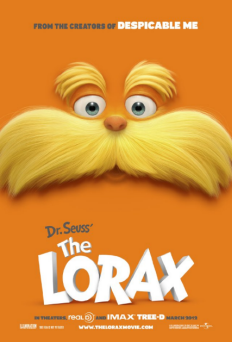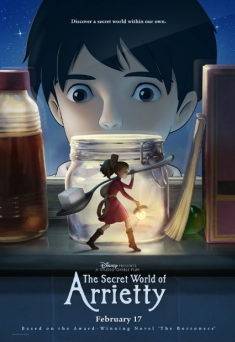Print Edition: March 7, 2012
 The Lorax and The Secret World of Arrietty, different in premise except that they both aim to appeal to children, are similar in approach in how they attempt to draw special attention to what the viewer should be hearing. How they work at this, and what sounds they create, is a different story.
The Lorax and The Secret World of Arrietty, different in premise except that they both aim to appeal to children, are similar in approach in how they attempt to draw special attention to what the viewer should be hearing. How they work at this, and what sounds they create, is a different story.
The Lorax opens with an automatic musical number snidely praising consumerism and complacency. The environmental message extolled within and whatever virtues or heavy-handedness it has can be attributed to the Seussian source material, so the real interest here is in how Despicable Me hot commodities Chris Renaud and team at Illumination Entertainment present it. Whether it’s Thneedville or the Truffala forest, the movie’s main character (voiced by Zac Efron) or its villain (who’s shorter than the Lorax, because shortness denotes instant humour and instability, right?), everything is rendered in an artificial neon sheen. The Lorax pokes fun at the evils of modern advertisement and the dehumanization of the marketplace, with jabs at how “people will buy anything if you put it in a plastic bottle” and how the key thing to cater to is people’s short attention spans. Yet its aesthetic makes no attempt at separating people from the plastic messages on concrete walls surrounding them. If The Lorax talks down mindless pursuits in the name of ease of access and hypnotizing bright colors, it only condescends to its audience and muddles its supposedly all-important message by bathing everything in that same veneer.
 Studio Ghibli’s work has touched on many “big themes” over the years, but whether the work of Hayao Miyazaki or someone under his tutelage, issues and concerns take far less importance compared to the animation studio’s propensity for sketching not just evocative landscapes and dwellings but people and their lives. Whatever thematic ideas of import that are in Studio Ghibli’s work tend to arise out of the way daily life is observed, rather than having events dictated by a need to speak to a supposedly unknowing audience. Where The Lorax wants its audience to listen to a message, The Secret World of Arrietty, adapted from Mary Norton’s fantasy novel The Borrowers, emphasizes listening to the natural world surrounding its characters. Arrietty’s uniquely miniscule point of view allows for a great deal of impressive animated climbing and rappelling, but the real wonder of the movie’s opening moments, which sees Arrietty on her first “Borrowing” mission, is Koji Kasamatsu’s sound design. Many an outsider’s tale emphasizes disorienting sounds and images to impress a feeling of unfamiliarity, but in Arrietty, there is an incredible sense of natural scale that extends beyond first impressions. The ever-present cicadas, the hum of a refrigerator, the tick of a clock are all sounds the human mind blocks out after a certain amount of time, yet their foregrounding here in the excursions of Arrietty and her father makes their every move palpable. Studio Ghibli understands that a hesitation is often more eventful than an action set piece, and it is that sensibility that carries throughout their work, which gives equal attention to the lives of crickets and centipedes, equal time to what happens in between encounters with strange new worlds.
Studio Ghibli’s work has touched on many “big themes” over the years, but whether the work of Hayao Miyazaki or someone under his tutelage, issues and concerns take far less importance compared to the animation studio’s propensity for sketching not just evocative landscapes and dwellings but people and their lives. Whatever thematic ideas of import that are in Studio Ghibli’s work tend to arise out of the way daily life is observed, rather than having events dictated by a need to speak to a supposedly unknowing audience. Where The Lorax wants its audience to listen to a message, The Secret World of Arrietty, adapted from Mary Norton’s fantasy novel The Borrowers, emphasizes listening to the natural world surrounding its characters. Arrietty’s uniquely miniscule point of view allows for a great deal of impressive animated climbing and rappelling, but the real wonder of the movie’s opening moments, which sees Arrietty on her first “Borrowing” mission, is Koji Kasamatsu’s sound design. Many an outsider’s tale emphasizes disorienting sounds and images to impress a feeling of unfamiliarity, but in Arrietty, there is an incredible sense of natural scale that extends beyond first impressions. The ever-present cicadas, the hum of a refrigerator, the tick of a clock are all sounds the human mind blocks out after a certain amount of time, yet their foregrounding here in the excursions of Arrietty and her father makes their every move palpable. Studio Ghibli understands that a hesitation is often more eventful than an action set piece, and it is that sensibility that carries throughout their work, which gives equal attention to the lives of crickets and centipedes, equal time to what happens in between encounters with strange new worlds.
The Lorax, which like other Seuss movie adaptations scrambles to add material to reach a feature running time, borrowing the gibberish spouting cutesy designs of Illumination’s previous production Despicable Me, to predictably dire results. All this compounds the problem of what this is supposed to be conveying. The message of how evil chopping a tree down can be is mostly confined to a musical number that shouts political cartoon imagery and one-liners, ironically touting “a portion of proceeds to charity” and other corporate niceties. But the main takeaway here is the cute bears and the luminous shine of Taylor Swift’s avatar’s hair. An Illumination introduction, the new crux of The Lorax’s plot is that boy wonder is doing all this searching for enlightenment to impress the girl of his dreams. The entire endeavor is done with a “yeah right” attitude that permeates seemingly every modern animation, and most curiously, in a key scene a mob is turned from viciously encroaching on the hopes of our protagonist to viciously encroaching on the life of the villain. It’s a cause to fight for, but one imagines Zac Efron could be swooping in to provide the world and Taylor Swift with the world’s last puppy or the last of a limited line of perfume given the mood of the picture. Environmentalism and beating up on those that crave money is the cool, “relevant” thing to do in movies (see also Tower Heist, In Time) right now. It’s just another thing to turn the mob towards, even as it still fuels the same engine of pollution. As Universal’s glitzy new logo emerges with a proud “A Comcast company” under the spinning globe, it’s hard to imagine any of the involved parties banking on anyone taking anything from this movie past a laugh, a distraction and a short feeling of uplift.
The Secret World of Arrietty, with its rather traditional way of creating then confounding an arbitrary villain, is a bit of a minor work when slotted next to something like Spirited Away or Howl’s Moving Castle. But as is always present in a Studio Ghibli work, there is a life coursing through the movie. One never doubts that there have been years of life prior to and following after the movie, and the central relationships of the movie are the kind that endure in children’s stories. Arrietty, like The Lorax, also contains the theme that humans destroy things with alarming consistency, but here it’s conveyed with a guarded optimism. It isn’t the key, the driving force, the thing on which the movie turns, instead the people are. Disney’s involvement means The Secret World of Arrietty is saddled with an unnecessary English-language dub, which like all of their previous efforts features some weak performances from people who are notable more for their names than their talents as voice actors. But all of the big studio’s involvement can’t contain the rhythms of conversation and the wind that blows throughout all of Ghibli’s outdoors. Studio Ghibli understands the best approach in animation is to tell it from the level of someone who still wants to find something in life, rather than someone caustically rattling off that they already have. It’s the difference between hypnotizing and realizing.


